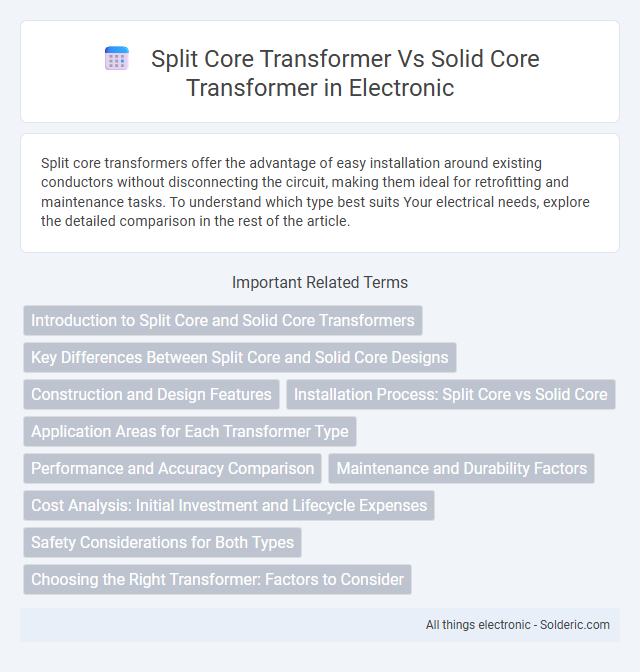Split core transformers offer the advantage of easy installation around existing conductors without disconnecting the circuit, making them ideal for retrofitting and maintenance tasks. To understand which type best suits Your electrical needs, explore the detailed comparison in the rest of the article.
Comparison Table
| Feature | Split Core Transformer | Solid Core Transformer |
|---|---|---|
| Core Construction | Core splits into two or more parts for easy installation | Single solid core, typically laminated steel |
| Installation | Easy installation without disconnecting the conductor | Requires conductor disconnection for installation |
| Applications | Retrofit and temporary monitoring | Permanent installations and high performance |
| Size and Weight | Generally larger and heavier due to split design | Compact and lighter |
| Accuracy | Moderate accuracy, slightly lower than solid core | High accuracy and better stability |
| Cost | Typically more expensive due to complex design | Cost-effective for large scale installations |
| Magnetic Flux Leakage | Higher leakage risks due to opening in core | Minimal leakage, continuous magnetic path |
Introduction to Split Core and Solid Core Transformers
Split core transformers offer easy installation by allowing the core to open and close around existing conductors without disconnecting the circuit. Solid core transformers feature a continuous magnetic core, providing superior magnetic flux efficiency and reduced losses in high-performance electrical systems. Your choice between split core and solid core transformers depends on factors like installation convenience and energy efficiency needs.
Key Differences Between Split Core and Solid Core Designs
Split core transformers feature a hinged design allowing easy installation around existing conductors without disconnecting wiring, while solid core transformers consist of a continuous magnetic core, requiring full disconnection for installation. The split core design offers convenience and flexibility for retrofitting applications, whereas solid core transformers provide better magnetic efficiency and reduced signal loss due to their uninterrupted core structure. Your choice depends on whether ease of installation or maximum performance is the priority for your electrical system.
Construction and Design Features
Split core transformers feature a hinged or removable core design, allowing easy installation around existing conductors without disconnecting wiring, while solid core transformers consist of a single, continuous magnetic core with fixed windings. The split core uses laminated silicon steel or similar materials to minimize eddy current losses, with precise gaps to enable separation and reconnection, whereas solid core transformers have tightly assembled cores to enhance magnetic flux efficiency. The construction of split core transformers prioritizes convenience and retrofit capability, while solid core transformers emphasize structural integrity and optimized magnetic performance.
Installation Process: Split Core vs Solid Core
Split core transformers offer easier installation because their hinged design allows you to clamp them around existing conductors without disconnecting wiring, minimizing downtime and labor costs. Solid core transformers require the conductor to be threaded through the core, which often involves disconnecting and re-routing cables, making installation more time-consuming and complex. Choose split core transformers for retrofit applications where quick and non-intrusive installation is essential, while solid core units are preferable for new installations with straightforward wiring access.
Application Areas for Each Transformer Type
Split core transformers are widely used in retrofit applications, energy monitoring systems, and portable equipment due to their easy installation without disconnecting existing circuits. Solid core transformers are preferred in high-power industrial applications, power distribution networks, and electrical substations because of their robust construction and superior magnetic efficiency. Each type serves distinct operational needs, with split core suited for flexibility and solid core optimized for durability and performance.
Performance and Accuracy Comparison
Split core transformers offer greater flexibility for installation without disconnecting circuits, but may exhibit slightly lower accuracy and increased magnetic leakage compared to solid core transformers. Solid core transformers provide superior performance in terms of measurement accuracy and reduced signal noise due to their continuous magnetic path and robust construction. In precision applications like power metering and protection relays, solid core transformers generally outperform split core variants by delivering more stable and reliable current transformation.
Maintenance and Durability Factors
Split core transformers offer easier maintenance since their design allows for quick installation and removal without disconnecting existing wiring, reducing downtime. Solid core transformers typically have superior durability due to their robust, uninterrupted magnetic path, resulting in less vibration and noise over time. Your choice depends on whether you prioritize convenience in maintenance or long-term structural durability.
Cost Analysis: Initial Investment and Lifecycle Expenses
Split core transformers generally have a lower initial investment cost compared to solid core transformers due to easier installation and reduced labor expenses. Lifecycle expenses for split core transformers may increase slightly because of potential durability concerns and maintenance needs, whereas solid core transformers typically offer higher longevity and lower maintenance costs over time. Evaluating total cost of ownership requires balancing upfront savings against long-term reliability and service expenses.
Safety Considerations for Both Types
Split core transformers allow safer installation by enabling easy retrofitting around existing conductors without disconnecting circuits, reducing electrical hazards and downtime. Solid core transformers offer enhanced structural integrity and are less prone to mechanical stress, providing consistent safety under heavy load conditions. Your choice should balance the ease of installation offered by split cores against the robust durability and fault tolerance inherent in solid core transformers.
Choosing the Right Transformer: Factors to Consider
Choosing between split core transformers and solid core transformers depends on installation needs, as split core transformers offer easy retrofit without disconnecting circuits, suitable for maintenance and upgrades. Solid core transformers provide higher efficiency and durability, making them ideal for new installations requiring consistent performance and minimal losses. Consider factors such as accessibility, installation complexity, load requirements, and long-term operational costs to determine the optimal transformer type for your application.
split core transformer vs solid core transformer Infographic

 solderic.com
solderic.com